Five swords are better than one. We Rediscover the Best, Forgotten Hack'n'slash Mechanics

- We Rediscover the Best, Forgotten Hack'n'slash Mechanics
- Painter, plasterer, necromancer
- Show me your wares
- Stay awake, explore, level up
- Skirmish on thin ice
- Five swords are better than one
- Nothing about me without me
Five swords are better than one

We can talk about not only the combat, but the whole gameplay idea in the case of Dungeon Siege , which returns like a boomerang in my considerations. Well, something, perhaps indecision whether it should be a classic cRPG or a modern hack'n'slash, or perhaps a flash of genius, made the creators of this cult game implement not a single protagonist, but the entire team, which in scale of a genre that already had its history was an innovative procedure . The closest cousin of this idea, and therefore a potential imitator, seems to be... SpellForce and missions dissociating themselves from the RTS component of the game, which is nevertheless a strategy.
If I had to point to another hack'n'slash game that comes close to similar solutions, it would be Shadows: Heretic Kingdoms . First of all - Games Farm's work also stands astride between a classic cRPG and a typical hack'n'slash - it strongly focuses on the story and slightly more intimate clashes. As for the team... Well. While the main character of the movie Split can be called a team, yes, in this game we control the team. A team of souls residing in one body, specifically a demon that can freely change form within the collection of souls in its possession. At any given moment, our "team" may consist of three souls and a demon in its original form. We develop each character separately, we equip them separately... That's a team, alright.
In addition, what was supposed to diversify the game in terms of gameplay and achieved its goal was the ability to jump between the worlds: the real one and the spiritual one. This solution actually diversified the gameplay, although it did not resonate with the hack'n'slash vibe as similar mechanics did a bit later in The Medium or Ratchet & Clank: Rift Apart .
